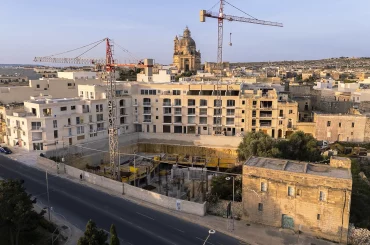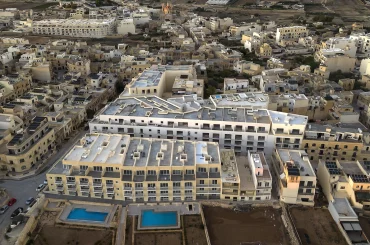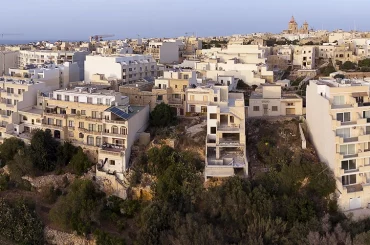Head of conservation of the NGO Birdlife Malta, Nicholas Barbara, described works at the cliff’s edge near Ta Cenc as “totally insensitive to the ecology of the area, in conflict with the area's designation as a Special Area of Conservation (for its flora and habitats) and a Special Protection Area (for nesting seabirds).”

This website revealed the works on land belonging to property magnate Joseph Portelli and his partners in an investigation published last Sunday. Part of the land falls on a Natura 2000 site, an EU-level protected area. The protected area runs in a strip of around 75 metres stretching back from the cliff’s edge, designed to protect the largest colony of nesting scopoli’s shearwaters in the Malta Islands, as well as yelkouan shearwaters and yellow-legged gulls.
Since the investigation was published, there has been attempts to cover up some of the works.
Natura 2000 sites are under legal custody and management of the Environment and Resources Authority (ERA).
Birdlife's Nicholas Barbara was scathing of ERA's failure in letting these works happen. He said: “The land around and the seas beyond the cliffs at Ta Cenc is protected on paper, with the legislative backing to enforce any activity that goes against its protection. What is missing is an effective enforcement with enough of a deterrent that would even discourage the wealthiest of any developers from taking such risks.”

Sources within ERA who spoke on condition of anonymity said that a nature permit issued by ERA is needed to carry out the kind of works that had taken place on the part of the land that falls on a Natura 2000 site.
Yet ERA did not respond to questions sent officially to its media spokespersons on whether a permit for the works had been granted, and what management measures were in place to protect the cliffs. Another question asked what action ERA would be taking against the works.
The only reply by a spokesperson was that “issues concerning rural rooms are addressed by Planning Authority enforcement.”
The developers extended a dirt road by 100 metres to the cliff's edge, spread rubble over the garigue, built 5 round huts that appeared to be shaping up into corbelled huts, and rebuilt ruined rubble walls higher than they had been and embedded large-diameter plastic drainage pipes in deeply into them.
Barbara denounced all of these works, which took place on the Natura 2000 protected area, saying that “reconstructing rubble walls, a habitat in itself, is detrimental to the ecology of the site”, and that the dirt road opens “access to offroad vehicles in turn making the habitats in the area less viable.”
He said: “It appears that the intended use of such an area is beyond anything agricultural. Any activity which may introduce noise, light, vibrations or even any form of entertainment, farming or catering establishment will present a number of threats to seabird populations from direct disturbance of the colonies at night, to aiding invasive species such as rats occupying areas close to seabird nesting sites.”
Rats are a threat because they prey on shearwater eggs and chicks. Invasive plants upset the ecological integrity.
After the article was published on this website, heaps of stones that had been placed near stone huts were removed, and the plastic drainage pipes were cut down to wall level.
Barbara said that other threats to the seabird colonies are light and noise pollution. The birds visit their nests in crevices on the cliff-face between May and September. Shearwaters are extremely shy, and disturbed by light.
Another complication of nearby lights is that fledgling birds, upon flying out of the nest, become disoriented by light and fly inland, rather than towards sea. These then land and become stranded (shearwaters are not able to take flight from the ground; they normally hurl themselves into flight from cliff ledges).
This is one of the reasons, Barbara said, why nearby development “might still impact the viability of such protected areas.”
He added: “Threats such as light and noise pollution can be felt from kilometres away, let alone from a development zone which spans so close to the cliffs. We have been advocating for ERA to adopt buffer zones for such situations, however such recommendations have to date not been heeded, to the point that current development zone policies may still permit huge developments just outside the border of Natura 2000 sites.”

The developers responsible for the works at cliff's edge, Excel Investments Limited, bought a strip of land stretching from the cliff’s edge to the fringes of the development zone where they have a project for 124 flats.
Aside from this development, another large development, belonging to Malla Developers Limited, is taking place a little further to the east, consisting of 42 flats. It is situated just 250 metres from the cliffs.

Excel’s 124 flats are situated 350 metres from the cliff. These 124 flats have been divided into three separate development applications. Two have been granted, and a decision on the third, consisting of 73 flats, was deferred earlier this week by the Planning Commission. It had been recommended for refusal but, in a move harshly criticised by the NGO Moviment Graffitti, the Planning Commission referred the case to the Planning Authority’s chairperson or Executive Council on a point that had already been assessed by the Planning Directorate, which is the technical unit within the authority.
As for the works on the strip of fields between the flats and the cliffs, residents told this website that Planning Authority officials have inspected the area in the past few days. This website has now reached out to the Planning Authority.





